Looking for the Creator Flywheels course?
Click to view the course:
What is a flywheel?
My first real life encounter with a flywheel was on a water well in South Africa.
I was working at an orphanage where one of our projects was to provide a reliable water source. Because electricity was unreliable, we mounted a hand-powered pump. But we couldn’t use the kind of pump you drive up and down to bring water to the surface because it would take far too much effort to operate. So instead, we installed a flywheel.
The flywheel was a large metal disk that used a rotational force to pump instead of a linear up and down force. It was incredibly hard to get started (it took two of us with all of our strength to get a single rotation), but it got easier with every rotation. Once the flywheel had momentum, I could spin it easily with one hand.
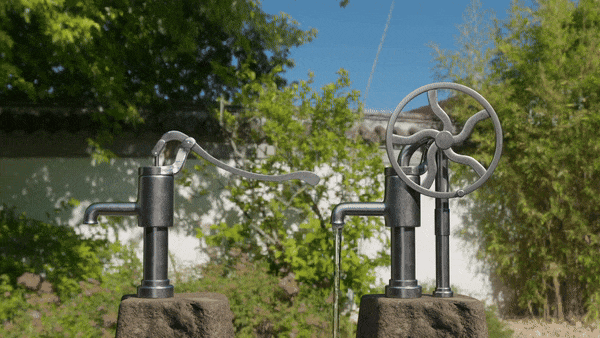
In his bestselling book, Good to Great, Jim Collins suggested that truly great companies are driven by flywheels. They turn their separate business activities into repeatable flywheels that drive their business forward with every rotation.
I want to show you how to take the concepts I learned in Africa, and by studying the many of the top creators using Kit, and apply them to your business as a creator.
Creator flywheels
As a creator, you often take the traditional hand pump approach without realizing it.
You stare at the blank page and watch your cursor blink.
It’s time to create new content, but you feel stuck. What should you write about? What should you say?
You open social media in a new tab. You check your email. You glance at the notifications on your phone. Anything to distract you from writer’s block.
This is what it feels like to have no flywheel.
A flywheel builds momentum. A flywheel’s inertia, or kinetic energy, keeps things spinning despite any fluctuations. When your business is driven by content, a flywheel is crucial for combatting lack of motivation and inspiration.
At rest, a flywheel is heavy and hard to rotate. But once you get it spinning, it becomes easier to keep spinning.
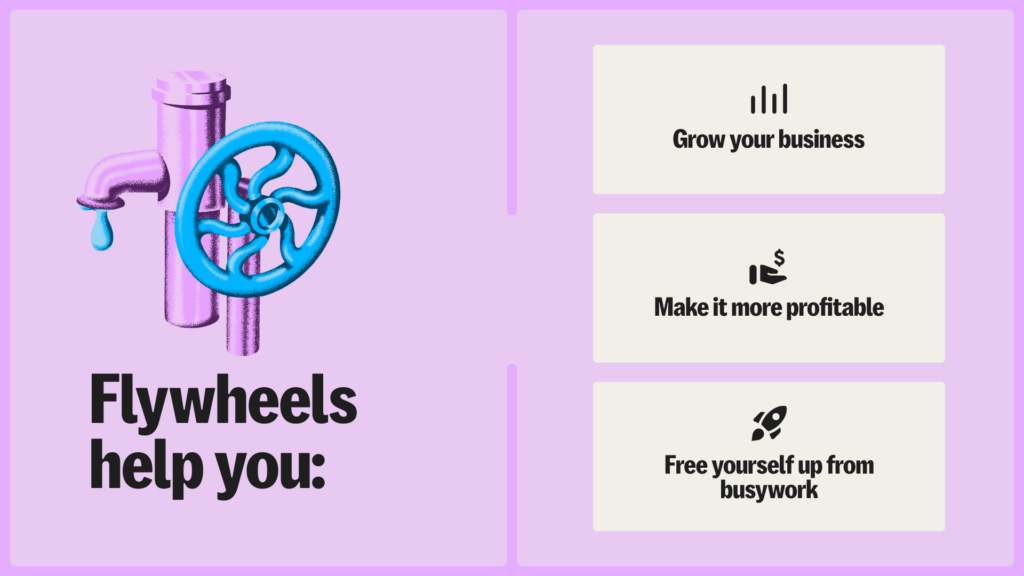
The three laws of a flywheel
For a flywheel to be effective, it needs to meet three criteria:
- Activities flow smoothly from one into the next
- Each rotation is easier than the previous rotation
- Each rotation produces more than the previous rotation
It should grow smoother, easier, and more effective with each rotation.
Let’s take a look at each of the three laws in detail:
Law #1: Activities flow smoothly from one into the next
It’s not enough to take random, disparate tasks and stack them next to each other. To function as an effective flywheel, each task needs to flow smoothly into the next task.
- What is the most sensible order of tasks?
- Which tasks naturally flow into each other?
- How can you make transitions even smoother?
- What steps can you break down into even small steps?
As an example, let’s take a look at how you could take the different steps needed to create new content and grow your email list and make the parts flow smoothly into each other.
Content idea flywheel
The most difficult time to come up with new topics is when you sit down to create. Wouldn’t it be so much easier if someone else came up with topics for you, and all you had to do was create?
Instead of guessing what topics will resonate, ask your subscribers! They’ll give you an endless stream of topics. All you have to do is set up this simple flywheel.
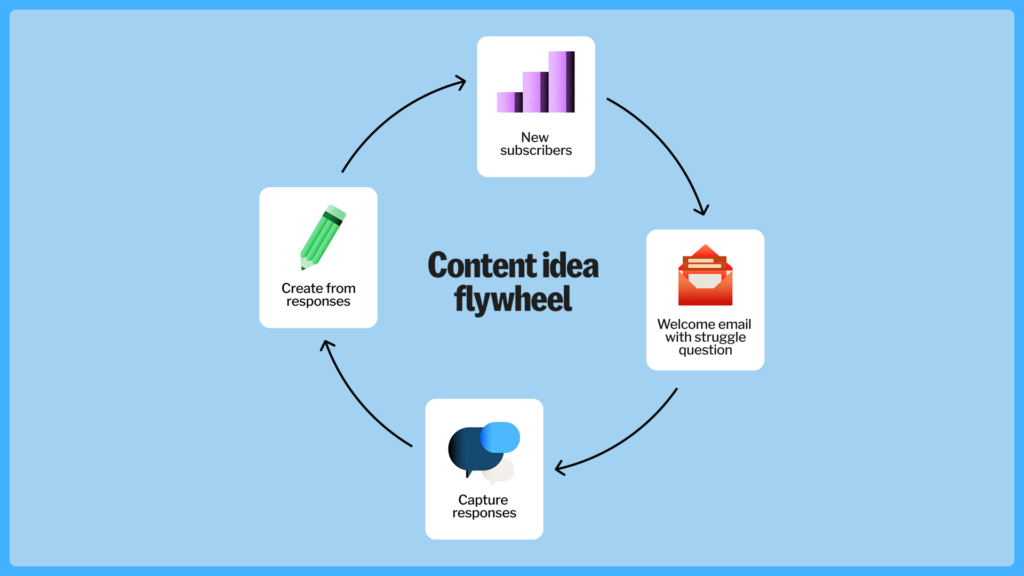
1. Lead magnet
Rather than ask people to “sign up for your newsletter”, offer some sort of opt-in incentive. This could be a PDF guide, email course, ebook, video series, etc.
Your lead magnet doesn’t have to be complicated. You can always tweak and improve it later, so don’t overthink it.
2. Welcome email
Set up an autoresponder to send a welcome email to new subscribers. Tell them what they can expect from your newsletter (and when), but at the end of the email, ask them to reply:
Before you go, what would you say your biggest struggle is right now when it comes to {topic}? Feel free to reply to this email. I read every response!
There are many different ways you can ask this:
- If you write a food blog:
- Ask: “If you could pick one recipe you want to learn to cook, what would it be?”
- If you run a financial podcast:
- Ask: “What financial concept do you struggle to understand and wish you knew more about?”
- If you write a sports newsletter:
- Ask: “What’s an obscure sports story you love to tell to people?”
3. Capture responses
Set up a filter in your inbox to collect replies to this welcome email (it’s as simple as filtering on email subject for “Re: {Welcome email subject}”). If you want to get fancy, you could even set up a Zapier zap to send these replies straight to a spreadsheet or Airtable.
4. Create content
The next time you sit down to create content, instead of guessing at the topic, simply look at the label in your inbox (or spreadsheet) for ideas. Pay special attention to topics that multiple readers have mentioned
The new content you publish brings in new readers, who then subscribe to get your lead magnet, reply with more content ideas, and now you have endless topics to research, write, and share.
Every step flows smoothly into the next, and the flywheel keeps spinning!
Law #2: Each rotation is easier than the previous rotation
So far, you’ve made sure each part of the flywheel flows smoothly into the next. But once the flywheel completes a rotation, the next rotation should be even easier. An ideal flywheel builds momentum and propels itself forward, spinning more easily each time.
A good example of this is a testimonial flywheel that makes it easier to get new testimonials with each rotation.
Video testimonial flywheel
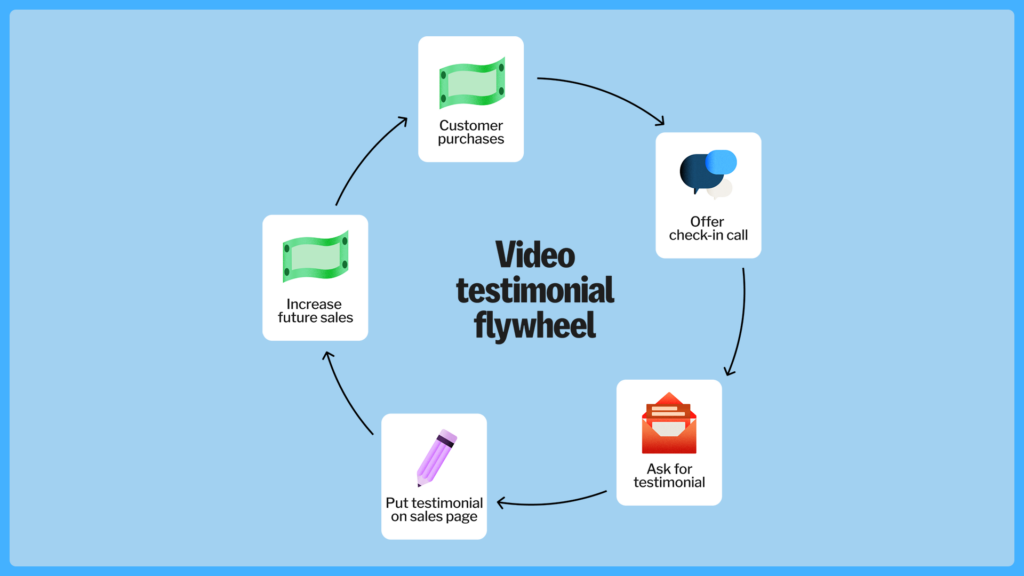
Testimonials are a great way to instill confidence in prospective buyers. The more examples they see of people like them purchasing, using, and getting value out of your product or service, the more likely they are to buy.
This flywheel is a good fit for higher-priced products and services, because it does require some of your personal time. However, it’s extremely effective at gathering high-quality video testimonials which will help you sell more of your high-priced products and services.
1. Customer purchases
Find an ideal time to follow up when the customer will have experienced some transformation but may also have some questions. The ideal point to follow up could be days, weeks or months depending on the product.
2. Offer check-in call
Once you feel confident your customer has seen some results from their purchase, send an email to check in:
Hey there!
I thought I’d check in to see how things have been going for you with {product}. Hopefully you’re starting to see some results already, but I realize you may also have some questions!
I wanted to offer to jump on a 20-minute consultation call to answer any questions you might have and help you get clarity. There’s no extra charge for this, it’s just my way of saying thank you for being a customer.
If this sounds like something you’d find helpful, feel free to book a time using {this link}.
Talk soon!
On the call, make a point to actually help your customer. Treat the call as though you were paid $500 for the consultation. Wrap up the consultation when there are about 5 minutes left.
3. Ask for testimonial
This is a good time to point out that you should be recording the call from the beginning and inform the customer you’re doing so when they join. Tell them you’ll provide them with a copy of the recording afterward so they can refer back to it.
When 5 minutes remain, say, “Before we go, I wanted to ask: would you be open to providing a brief testimonial for {product}?”
99% of the time, they will say yes, in which case you can prompt them with the following questions:
- What was the biggest hesitation you had that might’ve kept you from purchasing?
- What results have you seen since using the product/working with me?
- What would you say to someone on the fence about purchasing/signing up?
Clip this section of the recording and edit out the places where you asked questions. The result is your video testimonial.
This testimonial is going to be so much more engaging than if you used an automatic testimonial gathering service, because their energy and enthusiasm for you and your product will be high right after you’ve personally helped them.
4. Put testimonial on sales page
Embed the finished testimonial video on your sales page, and repeat until you have as many testimonial videos as you want. Transcribe the video and use written excerpts in your sales emails and on social media.
5. Increase future sales
When prospects are able to envision themselves in your past customers’ shoes, and imagine experiencing their success, they will be more likely to buy. This will result in an increased conversion rate on your sales page. The more customers you have, the more testimonials you’ll get, and the flywheel continues to spin.
Law #3: Each rotation produces more than the previous rotation
Not only should each rotation be easier than the last, but it should also produce more results.
What if your newsletter grew itself, new subscribers referred a friend, you made money every time you sent an email, and acquiring new subscribers paid for itself?
This is exactly the setup Sahil has:
Million-subscriber newsletter flywheel
Sahil Bloom is college baseball pitcher turned investor and creator. In 3 years, he grew an audience to over 325,000 newsletter subscribers and 900,000 Twitter followers. His goal is to build his newsletter to 1 million subscribers as fast as possible, and he’s on pace to get there within the next couple of years. Here is the flywheel he’s using:
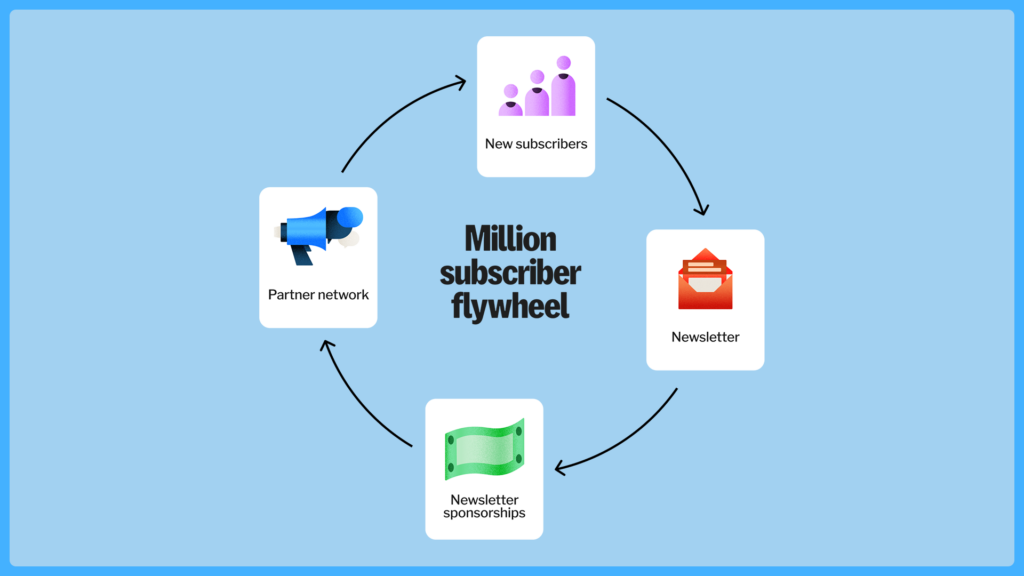
The million-subscriber newsletter flywheel is broken down into 4 steps:
- New subscribers — Sahil’s primary growth comes from his social media strategy. He started by mastering Twitter threads and then expanded to Instagram and LinkedIn to grow as fast as possible. Each platform is focused on driving subscribers by including a CTA to get on the newsletter.
- Newsletter — Sahil keeps his subscribers engaged by regularly sending two, insightful newsletters per week.
- Newsletter sponsorships — Our sales team sells sponsorships for Sahil’s newsletter through the Kit Sponsor Network. His total earnings in the month of February, 2023 were $22,000.
- Partner Network — Sahil then reinvests everything he earns into sponsoring newsletters with SparkLoop’s Partner Network. He pays $1.50 per subscriber other creators refer to him. Netting him around 14,500 new subscribers per month (~480 per day).
This is a smooth process where Sahil knows exactly what he needs to produce each week to keep the flywheel turning. But the important lesson here is that each rotation of this flywheel drives more, and more results.
The bigger his newsletter grows, the more sponsors pay for each issue, which gives him more revenue to reinvest in acquiring new paid subscribers. On an early turn, this flywheel produced 10,000 new subscribers per month. Now that it’s grown, this flywheel produces more than 30,000 new subscribers for Sahil each month.
It’s like a snowball rolling down the hill: it starts small and only grows a little bit with each rotation. But over time, it picks up speed and grows significantly with every rotation.
Sahil is well on his way to grow from a few hundred thousand newsletter subscribers to 1 million in a year because of this flywheel.
More examples of flywheels to learn from
Here are some more examples that might give you some ideas for how you can use flywheels in your business.
How Kit makes creators the heroes of our brand
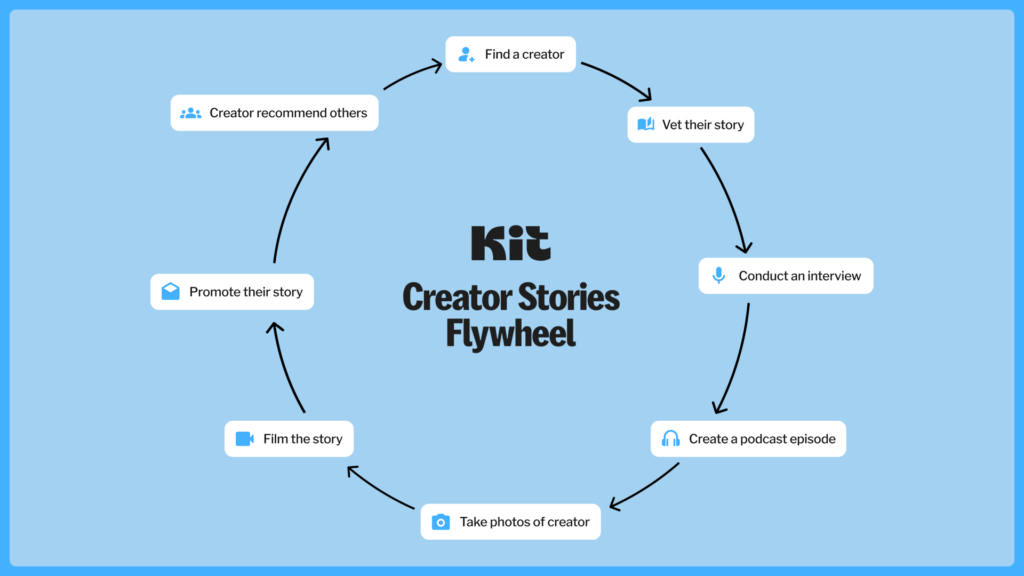
At Kit, we love to tell the stories of the creators we serve. Many companies have a process for writing case studies or gathering testimonials, but I’ve never seen a storytelling flywheel on the level of what our resident storyteller, Isa Adney, has created at Kit.
Here’s the flywheel:
- Find a creator — Isa tells everyone in the company she is looking for stories of creators with unique businesses doing interesting things with Kit. This means our account managers, product team members, and customer support team members send her a steady stream of story leads.
- Vet their story — The creator fills out a pre-interview survey that helps Isa ensure they’re the right fit. If they are, this survey also helps her prepare the interview questions.
- Conduct an interview — During a two-hour interview, Isa asks questions about their creative journey and creator business. She specifically asks how they are having success with Kit. Our marketing team then uses these answers to write a case study.
- Create a podcast episode — The finished creator story, which has been thoroughly edited and fact-checked by the creator, serves as a script for Isa to record an episode of the I Am A Creator podcast.
- Take photos of the creator — We conduct a full documentary-style photoshoot for each creator we interview. These photos are used to illustrate the story as well as throughout our own marketing and social media. We give the photos to the creator for their own use, and, when permission is given, they are also uploaded to our Unsplash account for other creators to use in their own marketing. We now have over 40 million views of our photos.
- Film the story — While many of the stories live exclusively in written and podcast form, we turn some of the stories into short documentary films. We like to select stories with a strong visual element, or another level of depth, that would make for an engaging film. Together, Isa and our talented filmmaker, Henry, coordinate a 3-day film shoot from which we produce an episode of our I Am A Creator docuseries (which is currently in its 3rd season).
- Promote the story — Our team writes foundational promotional copy for each story and passes it along to our marketing team who sets promotional goals and writes additional copy to promote the story across all of our channels. We also provide the creator with assets and copy that they love using to promote their story to their own audience as well.
- Creators recommend others — All of this turns into more customers through which we filter to find more stories to tell. During many of the interviews, creators often recommend other creators whose stories we also end up telling.
Not only are these stories published on our site and YouTube channel, they also are woven through every bit of our marketing. When I’m writing an article, or putting together a talk, I’ll ask Isa, “Who is a creator that got started before they felt ready and it paid off for them?” or, “Do you know of a creator who struggled to get traction until they focused on a specific niche?”
Isa has great examples each time—complete with photos, testimonials, and a story. She’s also building an internal creator story database that will make it even easier for anyone on the team to find and use these assets.
This storytelling flywheel becomes the heartbeat of all of our brand marketing efforts. It also means that we don’t use any stock photos in our marketing. 100% of our photos are real creators who use Kit—photos that we took ourselves.
Podcast guest flywheel
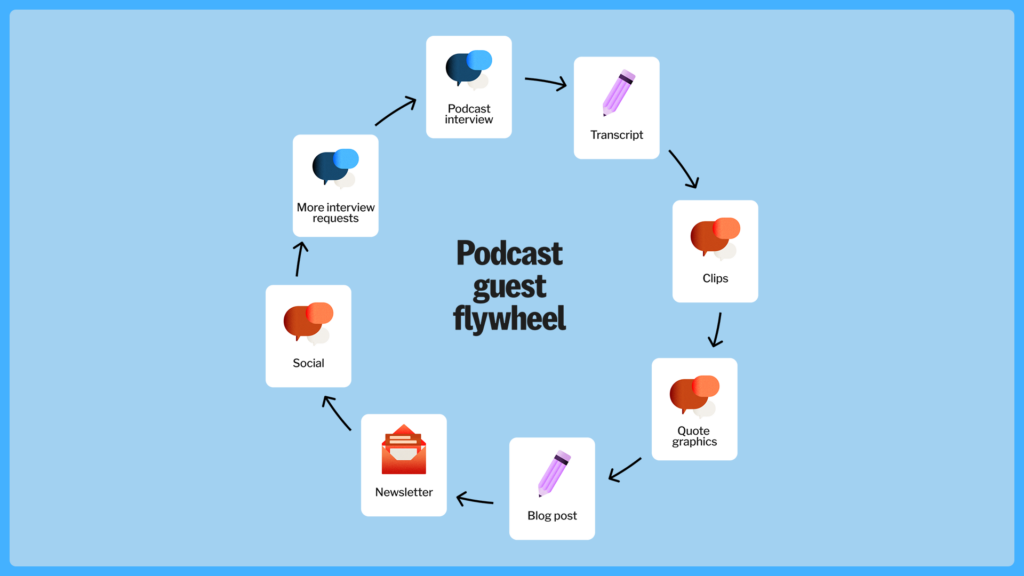
If you get a lot of podcast interview requests, it can be hard to justify setting aside the time to go on another show. While the answer may be an obvious “yes” if the podcast is popular, it’s less obvious if the show is small (since you only have so much time to go around).
But what if the point of going on a podcast wasn’t the podcast itself? What if going on podcasts was a significant part of your content creation strategy? What if you could simply show up and speak and, in doing so, automatically create blog posts, newsletters, and social media content?
Instead of thinking of the time you spend being interviewed on a smaller podcast as “wasted”, you can think of it as content creation time.
How would this work?
You’d accept the invitation with the understanding that you’ll be provided with the video recording afterward and allowed to repurpose the content however you see fit. Meaning you can clip it, transcribe it, turn it into blog posts, graphics, etc.
They get you as a guest. You get the content to repurpose. While larger podcasts may already have their own team for repurposing content, this usually isn’t the case with smaller shows.
You can then give the recording to your team or hire an agency to repurpose the content.
Now, going on a podcast looks like this:
- Podcast interview — Record the interview on video even if the host only releases an audio podcast. This will give you more repurposing opportunities. Stay for a few minutes after recording the show to build your relationship with the host. Explore collaboration and partnership opportunities (invite them to be a guest on your podcast, host a workshop together, promote each other’s newsletter, etc.)
- Transcript — The transcript helps you easily find the best things you said in the interview
- Clips — Make short clips of the best moments you found in the transcript and post on YouTube Shorts, Instagram Reels, TikTok, etc.
- Quote graphics — Edit the transcript of your best moment down to short quotes and turn them into quote graphics
- Blog post — Expand on the transcript of your best moments and turn it into a blog post (you can also embed your quote graphics here)
- Newsletter — Send the blog post as your newsletter (or link to it)
- Social — Condense the blog post into a Twitter thread and repost the Twitter thread as LinkedIn and Instagram carousels
Posting clips, threads, and carousels on social media will increase your visibility even further and result in you getting on more podcasts and feeding the flywheel.
Build your own flywheel
Flywheels are something I could talk about for hours. Too many creators are running their business on hard mode. By setting up a few strategic flywheels, you can set yourself free.
I’ve got endless examples from my own work on Kit as well as from having a front-row seat to watching the biggest creators online build their businesses on Kit.
The flywheels range in category, but examples fall nicely into three buckets:
- Grow your business faster
- Make more money
- Save a lot of time
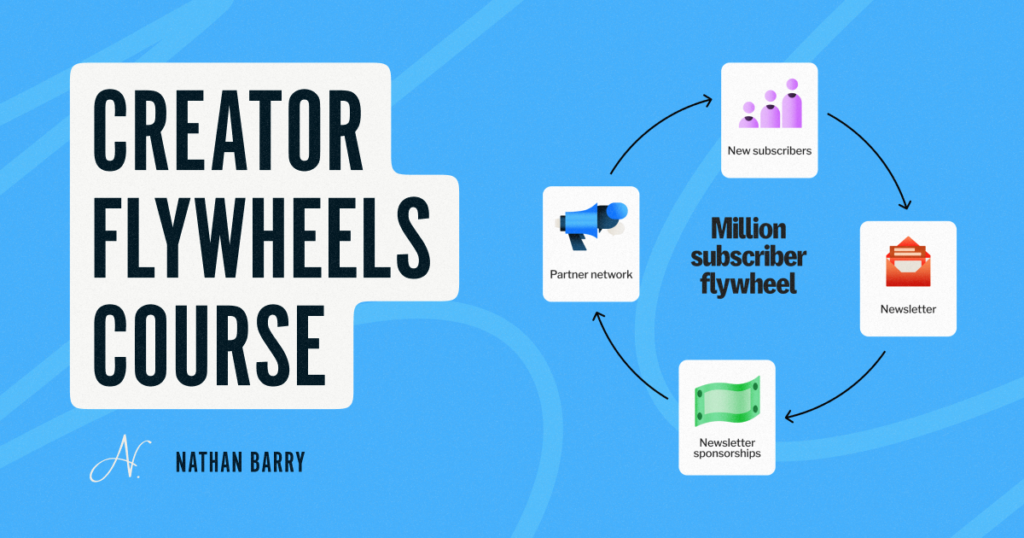
Creator Flywheels Course & Group Coaching Program
While it’s simple to describe the concept of a flywheel, there’s more to it than arranging linear steps in a circle.
- Which flywheel should you build first?
- How do you know if it’s producing results?
- How do you know whether your flywheel is set up correctly?
I knew this had to go beyond a blog post, and that’s why I created the Creator Flywheels course and coaching program. The course is something I’ve refined for over a year across four keynotes, two pilot programs, and countless live workshops. It’s made up of hundreds of slides and more than a dozen lessons.
But I found that teaching you the principles, and giving you the resources and worksheets, often isn’t enough to make sure you get results.
That’s why I’ve put together the group coaching program and community. So beyond getting lifetime access to the course, flywheel examples library, case studies, and resources, you’re also joining a community of professional creators working together to build their flywheels.
- The course gives you an education.
- The community gives you accountability.
- The coaching gives you live feedback, instruction, and motivation to implement these systems into your business.
Learn more at CreatorFlywheels.com »
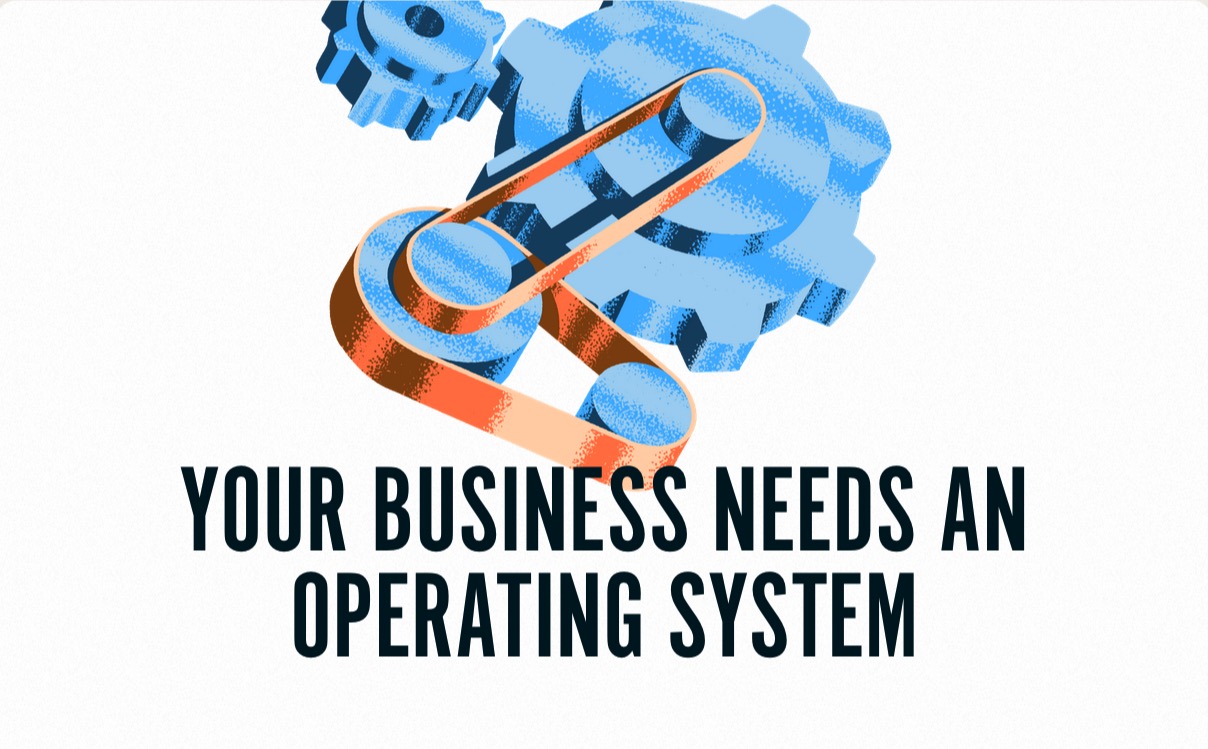


This is an interesting view of things. I am particularly surprised and in awe of how Sahil uses the flywheel. It takes guts to do this – because the flywheel only works if your content is above good.
I will create/or see things like a flywheel. Thanks, Nathan.
Excellent article. Well structure, and with GOLD information! Thank you for sharing :)
This article was an eye opener for me. I am just starting out with my funnel and this seems like such a natural idea to pursue. Thank you for this very informative article. M
My website is on WIX and I am currently using their automations BUT this makes me want to take another look at ConvertKit. Excellent content!
People don’t understand the power of fly wheels.
I was on a two hour walk with another creator this AM and he said I should be the Flywheel guy, given how much I evangelize the concept.
Like you, Nathan, I could talk about them for hours and hours 🤝
A great read.